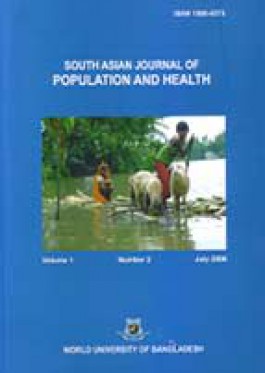
SOCIOECONOMIC DETERMINANTS OF MALNUTRITION OF CHILDREN AGED 6-71 MONTHS IN TWO SELECTED DISTRICTS OF BANGLADESH
Written by:U. K. MAJUMDER, M. NURUL ISLAM & DNR PAUL
The current status of malnutrition among the children aged 6 - 71 months was assessed in two selected districts of Bangladesh, namely, Dinajpur (a rice surplus district) and Bagerhat (a rice deficit district). A three-stage cluster sampling technique was used for selecting the sample households for each selected district. The prevalence of malnutrition was assessed using three indicators, such as stunting, under-weight, and wasting following the WHO guidelines and cut-off points. The prevalence of stunting, under-weight and wasting of 6 - 71 months children in Dinajpur were lower than those in Bagerhat. The households of Dinajpur district are relatively richer, live comparatively better life, and the children possess better nutritional and health status as compared to Baherhat district. Age of mother and socio-economic status (SES) of the HHs has been identified as the main contributing factors for stunted children in Dinajpur district while, age of children, mother's working status and SES of HHs appear to be the major contributing factors to the stunted children in Baherhat. The factors showing significant contribution to underweight children are age of children, age of mother, family size, HH's monthly income and poverty incidences in Dinajpur and age of children, credit receiving status, monthly income from agriculture and HH's per capita monthly expenditure in Baherhat district. The contributing factors for wasted children were family size and monthly income of the HHs in Dinajpur district while, there was no significant factors found in Bagerhat.
PATTERNS OF FAMILY PLANNING BEHAVIOR IN A RURAL AREA OF BANGLADESH: A STOCHASTIC MODEL APPROACH
Written by:S. M. SHAFIQUL ISLAM & ABDUL HAMID CHOWDHURY
A stochastic model has been developed in this paper to study the patterns of family planning behavior among 1060 couples in a rural area of Bangladesh based on information collected during the period between January 2001 and December 2004. The transition probability matrix formed by considering various contraceptive methods jointly with parity levels shows that majority of couples are not likely to change their current parity levels in a short period and continue to use their current methods of contraception. It has been found that at the lower parity levels current non-contraceptors are not likely to use contraception to bear more children and oral pill users are expected to use pills to achieve desired space between births whereas the users of other temporary contraceptive methods are likely either to switch to pill in order to delay births or stop using contraceptives to attain desired family size. At higher parity levels, couples are found to have a tendency to adopt sterilization in order to limit family size at four or five children.
CONSUMPTION BEHAVIOUR AND NUTRIENT QUALITY OF FAST FOODS: DEVELOPMENT OF A HEALTHY EATING INDEX FOR BANGLADESHI
Written by:ABU TORAB M. A. RAHIM, SABRINA MOUSHUMI & NAZNIN KHAN
A survey on consumer quality perceptions, preference, and intake pattern of Western fast food and traditional snack foods (ready-to-eat foods taken traditionally in between meals) was conducted among customers of some selected commercial fast food outlets in Dhaka city. Four hundred consumers of these foods were interviewed (56.5% male, 43.5



